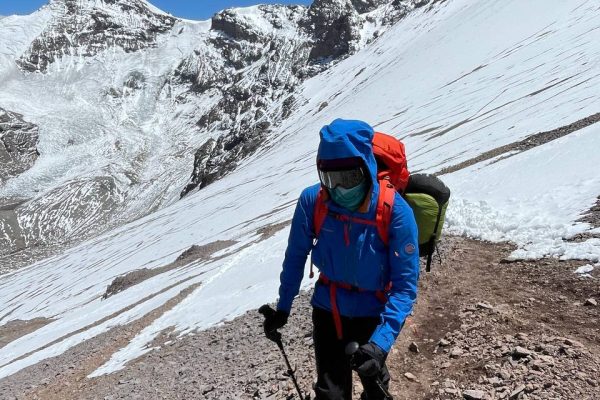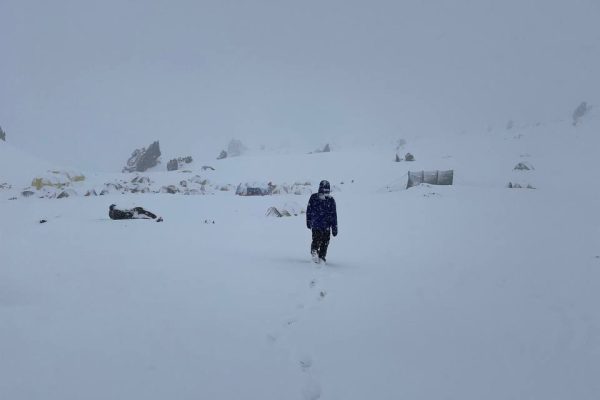Day 13. Camp Canada
The weather was sunny. Plaza de Mulas camp down below was getting smaller and smaller, gradually turning into tiny round multi-colored dots scattered among the bare brown rocks and dazzling white glaciers.
It took us a couple of hours to reach the first high-altitude camp, called camp Canada. It was quite difficult to walk up until the camp, especially in the last part: my lungs needed more oxygen. Every step left me breathless. My eyes were constantly jumpin around and trying to find subtle signs that we were already close. The camp played hide-and-seek with me and was not visible at all behind the rocks ahead.
The camp itself was small, but with wonderful views of the valley and the glaciers below. A group of medical professionals from the United States put tents nearby. They were investigating the quality of medical services in the national park. There’s just one question on everyone’s mind:
“When are you going to the summit?”
“We don’t know yet. We’re just doing our acclimatization for now. Tomorrow we’re going to the next camp and we’ll see.” – Chris replied to them.
After a short walk and admiring the wonderful panoramas of the mountains around, Chris collected some snow in order to boil water and prepare dinner for us. Our instant expedition food turned out to be very tasty: this time we ate mashed potatoes with vegetables and meat.
The weather forecast predicted bad weather. Somewhere in the evening it started to snow. We made love in a tent, setting our personal record at almost 5000 m above sea level 🙂 and went straight to bed. You won’t find any other entertainment here anyway. Tomorrow we have to get up early and move to the second camp.
Day 14. Camp Nido de Condores
After we woke up, we were cuddling for quite a long time in a sleeping bag, trying to warm our cold feet and waiting for the sun. From now on, it has become our ritual – to wait for the morning rays of light, so that they first heat the tent and then we can get up and cook breakfast. With the rising sun and temperature in our tent, our mood also rose at the same time.
After breakfast, we packed up one tent, all the things we needed for the following days, including gas bottles, a kettle, food, etc. Chris, as usual, carried a huge duffel bag. He is a robot. I always wonder how he is able to carry so much stuff. I had “only” two backpacks attached to each other. We had so much weight to carry, especially at this height, when every step gives is so difficult!
The closer we got to the second camp, the worse the weather became and the more difficult it was for us not only to walk, but also to breathe, talk, and concentrate. Especially right in front of the camp, we had to make a lot of stops to give our shoulders a break from the load, catch our breath and drink tea. The road seemed endless. The target was not visible: the whole surrounding was enveloped in thick fog. Only a couple of meters were visible ahead. Fresh and deep snow also made it difficult to climb. We simply drowned in it, in this giant white wave.
However, after some time, we finally saw first the wind beacon, then the flag, then the camp watcher’s hut, and finally the entire camp of Nido de Condores. Because of the thick fog, it was not clear where we should pitch our tent. We decided to put it right behind the gray wagon. Later, our American friends also settled nearby. Tired and exhausted, we quickly fell asleep.
Day 15. Rest day in bad weather
The whole next day we spent in a small tent in Nido de Condores, placed beautifully among giant mountain ranges. It was snowing. The rest of the 5 people from the team were supposed to ascend and join us. The sixth decided to stay back in the base camp due to severe coughing and insomnia.
When we went out for a walk, we just saw how our group was already settin up the tents at the top of the camp. Maybe it was a good idea that they hired porters to carry their tents and some of their gear. However, it was quite expensive. Chris and I decided to decline porters service because we already lifted all of our gear up.
Walking those 100 meters to the tents of the rest of the team seemed like an eternity: each step was extremely difficult. I felt like a feeble old man on the verge of his life, trying to get to the next pharmacy. How will I get to the top if it’s hard to take two steps down here?
It seemed a little strange to us that the team did not look for us first in order to pitch nearby, but you can understand them – tired, cold and hungry, they now had other priorities.
We were able to sit and chitchat for a while in the large group tent of Inca Expeditions, a local partner expedition company, and then returned to our tent: it was snowing with giant flakes and got very, very cold. In the tent, I noticed how my down jacket was all wet. This is bad news. I hope that by tomorrow I will have time to dry it. I will sleep with my jacket all night in a sleeping bag so it gets dry.
In general, I was not lucky with my gear this time: my hardshell jacket was also torn in several places, my new pants were too big, and my ski sunglasses constantly fogged up. I will need to update some of the equipment before my next expedition.
Most of the time, as I said, we spent in a tiny tent, communicating at a prearranged time with other team members via radio. Through the radio frequency of the park’s lifeguards, I heard the highest third camp, Cholera, and the park administration talking in Spanish. Tomorrow, some Canadians will try to climb to the top despite the terrible conditions: the mountain has not seen so much snow since a long time.
We had a small window on the side of our tent, through which I could hear what other climbers were saying and doing. I felt like some kind of neighbour grandma, carefully watching everything that happens on the street. Through this small window, I could watch the weather and wonderful sunsets, right from the sleeping bag, without leaving the tent and without exposing my tender sensual gay body to the harsh and ruthless cold weather outside 🙂 .
Tomorrow we want to climb to the camps of Berlin and Cholera. We weren’t sure if we should gtry to climb the summit the next day or just do an acclimatization trip?
After talking with others at the camp, we clearly understood that the chances of climbing to the very top were extremely small – the weather was unstable, there was a lot of snow, which increased the risk of avalanches.
























